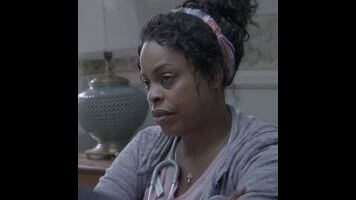“You did good, ma’am,” says Niecy Nash’s no-nonsense nurse DiDi to an elderly patient after she gives a little push and releases her bowels all over another nurse’s face. “You did real good.” With her compassionate dialogue, patient deliveries, and award-worthy side-eye, DiDi exemplifies the spirit of Getting On. She’s not unflappable. She’s just quiet. She takes a moment to collect herself before speaking when her sister-in-law gets on her nerves. At her angriest she sarcastically asks whether it’d be better to bounce a patient to a negligent nursing home or throw her out on the street. The show has the stakes of ER and the slapstick of Jackass, but Getting On is defined by its calm. No matter how grave or raucous it gets, Getting On keeps the volume down so it doesn’t needlessly disturb anyone. It’s the most peaceful show on television.
Whatever happens, HBO is pulling the plug on Getting On after this third season. That might have been cause for concern, but the show looks and feels exactly like it always has. No sense of closing up shop. No sign of budget cuts. Supporting actors like Mary Kay Place and Jayma Mays return, and the guest cast is filled out with other television luminaries like Rhea Perlman and Gloria LeRoy. There’s even room for a visit from Joanna Scanlan and Vicki Pepperdine, co-creators and stars of the original British version of Getting On. Dawn and Patsy are still obsessed with each other, and Jenna’s still working on her revolutionary system for classifying human feces by shape. It’s the same old Getting On, now with a slightly more urgent sense of finality. But Getting On is all about handling demise. Naturally it prepares for its own end like a pro, not with sound and fury but with moments and gestures that recommit to the show’s belief in the dignity and absurdity of life, made all the more poignant by the knowledge that this is the end. The gravity of death and the parade of life combine to give Getting On an uncommon mood. Serenity is a rare thing on TV.
There’s another way the story of Getting On mirrors the story in Getting On. For three seasons this unusual light-and-dark comedy has been somewhat undervalued. Them’s the breaks in the era of peak TV. But like so many other modest majors, Getting On is often just as funny, beautiful, and moving as the most touted series on the air. Fans of Orange Is The New Black would do well to check out HBO’s hospital comedy. Like Orange, Getting On is committed to dignifying women of all shapes and sizes. Its premise often reduces life to the physical. Silliness abounds. What Orange does with the prison industrial complex, Getting On does with hospitals. One scene where the children discuss how to treat their dead dad’s trophy wife plays out the show’s tension between money and care in microcosm, with generally decent people debating what to do with a woman who has outlived her usefulness to them. Getting On has such integrity it could never run over its villains to solve its problems. Instead it appeals to their senses of mercy, it convinces them of what’s right, it revels in the comedy of life. Getting On doesn’t just preach compassion, it lives it.
If that sounds like a homework comedy, rest assured the cast is drawn from Roseanne, Mad TV, and Reno 911! for a reason. Metcalf is a comedic Olympian, milking Jenna’s obliviousness and desperation for all they’re worth. Her reaction to being called “Nurse”—chuckle, snort, make sure you notice her indignation—is even funnier than expected, and that’s nothing compared to a snippet of her on the dance floor. (Nash also gets to perform, but the scene is so delightful it’s criminal to spoil.) From about the moment we see her again, Jenna’s hawking new products, a “potentially ground-breaking vaginal cream” with moisturizing balls as well as the Barbet anal horn, which we later get to see in action. Getting On is drenched in bodily fluids. A pile of vomit becomes a running gag. Laxatives, ejaculation, and dialysis rule the plot. However placid its demeanor, underneath the show is as bawdy as anything on television.
Three seasons in, the body comedy can be a little predictable. Take the scene where the constipated patient finally evacuates her bowels on a nurse. You see it coming from a mile away. But then the nurses react to the incident with funny, moving humanity, and Getting On demonstrates what makes it so special.


 Keep scrolling for more great stories from The A.V. Club.
Keep scrolling for more great stories from The A.V. Club.